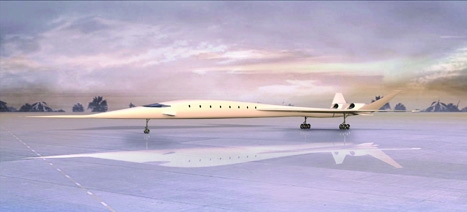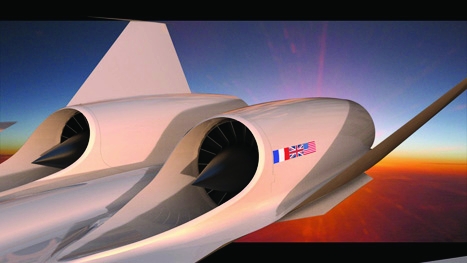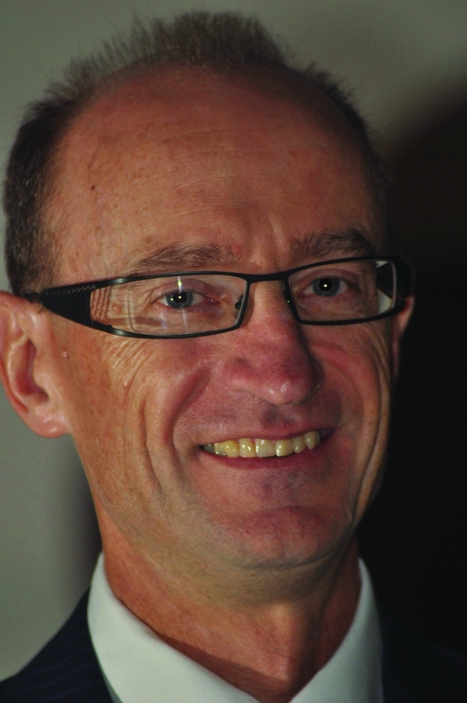
When you claim to have an engine design that will enable flights from London to New York in less than two hours, you need the right credentials to back you up. And when you also say your aircraft will fly at almost four times the speed of sound without creating a sonic boom and that it will produce a fraction of the emissions of current planes, you should be prepared for more than a little scepticism. For the man behind the HyperMach Sonic Star project, none of this is a problem.
Richard Lugg’s plans may be ambitious, but he has reasons to be self assured. His CV includes time working on the Space Shuttle and cruise missiles for the US Air Force. He boasts NASA, Lockheed Martin and Boeing as previous clients. He has expertise not only in engine and aircraft design, but also composites, power electronics, alternative energy and nano-scale heating and cooling systems.
‘There wasn’t really anything I wasn’t involved in that’s needed in a mach 4 hypersonic jet. There hasn’t been anything I’ve not done. I’ve been very fortunate ― the timing’s just happened,’ he told The Engineer after a recent trip to the UK, where HyperMach plans to develop the Sonic Star thanks to support from the government.
Although born and raised in Britain, Lugg followed his father into the US aerospace industry, via a detour into medical research that led him to work with NASA on how the impact of deep-space flight could affect the design of ships. But perhaps his most important experience was his involvement in the early stages of the NASA Hyper-X programme in the mid-1990s, which would eventually produce a world-record-beating unmanned aircraft ― the scramjet-powered X-43A ― which flew at almost 10 times the speed of sound for 11 seconds in late 2004.
‘I was quite enamoured by the Hyper-X mach 10 programme,’ he said. ‘The performance and what we were attempting to do was so amazing. If you said mach 10 to someone, they were not going to believe you.’
Before Hyper-X achieved its record speeds, Lugg had mapped out his own engine and aircraft design. He is keeping tight-lipped about the technology, but describes the engine as a hybrid and says part of the solution involves powering half the plane’s operations electrically to reduce the load on the fuel. ‘We’re going to burn less fuel going six times faster than anyone else, with an 80-90 per cent emissions reduction along the way,’ he said. ‘And 50 per cent less sulphur dioxide [and] nitrogen oxide, which for high-altitude flights are more concerning than carbon dioxide.’
These goals arose out of a very singular focus. ‘We had a very specific mission and objective in mind. It was based on failures by big engine companies and the impact of environmental regulation,’ he said. ‘It had to be a clean-sheet design and revolutionary in order to achieve the environmental regulations. And there was no point in spending a single pound on a project like this unless you had a solution to the sonic boom. It’s just not allowed in our world.’
Sonic boom ― the incredible noise produced by craft travelling faster than the speed of sound ― was one of the issues that prevented Concorde from being more successful. Possibly on this basis, HyperMach has revealed details about the technology that will prevent sonic boom. The Sonic Star craft will project a stream of ionised gas in front of it as it flies, creating an ‘electromagnetic vacuum’ that will absorb pressure waves, created as the plane flies faster than sound, which produce the boom.

But Concorde also suffered from serious business-model problems, some of which Lugg believes his technology will address. ‘Concorde did not make money as the engine burnt too much fuel too quickly,’ he said. ‘We address that with new combustor technology, and we knew from way back that you had to have hypersonic engines that burned better than the efficiencies of engines on jumbo jets today. And that has never been achieved until now.’
“The Sonic Star’s going to burn less fuel while going six times faster than anyone else, with an 80-90 per cent emissions reduction along the way”
Perhaps another advantage is that Lugg isn’t just an engineer, and claims substantial commercial expertise thanks to involvement in the two companies that channelled his technical skills. ‘What was unusual was that I was a hybrid scientist and businessman,’ he said. ‘So I had a foot inside NASA and a foot inside private industry… I was able to manage 10 or 20 multi-million-dollar projects at the same time. It happened by default… but I’ve always loved a challenge.’
For all Lugg’s experience, with a project this audacious there will always be non-believers. He may have been developing his designs for 10 years, but reaching the goal of first commercial flights by 2021 is still an incredible challenge. And with an expected cost of up to $1bn (£639m), the people he’ll have to work hardest to convince are investors.
But his confidence is unwavering. ‘When you have a brand-new, revolutionary technology, there’s always a lot of risk,’ he said. ‘And you want to reduce as much risk as you can and demonstrate your revolution so people get a handle that this is real and is going to happen. The people you pay most attention to are your investors.’
The demonstration will take the form of three unmanned aircraft built with rapid prototyping techniques, the first of which will be a low-speed vehicle that will test landings and take-off and is scheduled for take-off in a year’s time. That should be followed in 2014-15 with a vehicle that will demonstrate the sonic boom technology. Finally, in 2016 a larger craft will display all the systems and technology.
In the meantime, Lugg hopes computer simulations will help bring people on board. ‘Along our pathway, we’ll be developing this new combustor in the engine system in the next couple of years,’ he said. ‘Prior to that, we’re like other aerospace companies that use engineering and numbers and simulations; that’s real data… We’re looking at nitrogen oxide and carbon dioxide in a combustion process in real-time simulations. Some of our engineering systems are so complex we have two supercomputers.’
Ultimately, it will be down to Lugg to persuade enough backers to see the project through. And he thinks the ambitious nature of his plans could be the convincing factor. ‘The technology exists; it’s more about organising the human beings to make the creation a reality,’ he said. ‘As an example, we’ve been approached by people in the freight business who’ve said we’ve created same-day air delivery instead of next-day. It’s those kind of things as far as ambition and boldness that are also carrying this forward ― saying this is achievable and saying here’s a reason this needs to be achieved because now you have x customers.’

Richard Lugg
Biography
Chief executive officer
HyperMach Aerospace Industries
Education
1982 BA mathematics, Maine University
1984 MS aerospace engineering, Alabama University
1986 MA physiology and clinical medicine, North Carolina University
Career
1986 Research associate, Duke University Medical Center
1987 Director of marketing, START Physical Medicine Clinics of Arizona
1990 Director of technology and business strategy, Gorham Advanced Materials Institute
1995 Manager of marketing and technology development, Albany International Techniweave
1998 Director of business development, Fiber Innovations
1999 Vice-president of operations and technology commercialisation, Aspen Systems
2001 Senior partner, Arthur D Little
2004 Chairman and chief executive officer, SonicBlue Aerospace
2008 Chairman and chief executive officer, HyperMach Aerospace Industries
Q&A Made in Britain
Why have you decided to develop the craft in the UK?
We’ve had a lot of interest and support from the British government. And we’ve not been able to achieve that with the US government. Also we had relationships in Europe and Britain, so it made sense to us to bring everything here. And I was born and raised in Britain.
Why do you think the US government wasn’t so interested?
The US is so very much largely focused on defence applications and technology. They put most of the federal money into defence expenditure [rather] than civil. We’re not big and when they look for innovation and new technology they turn to Lockheed [Martin] and Boeing. They don’t turn to the smaller companies, although there’s now a new programme where politicians have recognised to be innovative they’ve got to get focused on the small companies. [Also] Europe is so much more sensitive to the environment and the culture of the US is definitely not that.
What do you think of the UK’s business culture?
The UK is maybe not the best [place for entrepreneurship], but history is what you want to pay attention to. In aerospace, there’s been more that’s happened in Great Britain in the last 80 years than nearly any other country in the world… I think England has a fabulous history in aviation, and we think it has the perfect business economic culture to grow our company here, and Britain is pushing hard to have more of that.
How do you think Sonic Star will affect the rest of the aerospace industry?
It’s fine to have a 10-year programme but that doesn’t mean anything unless you really have a plan for the future. So we have engine technology that’s not just flying through the air at mach 4 but we feel we have technology we could contribute to, for example, space flight. The plan is to go several generations ahead. On the environmental side we’re focused on noise, emissions and operating costs. And the biggest cost in our business is the cost of fuel.




Red Bull makes hydrogen fuel cell play with AVL
Formula 1 is an anachronistic anomaly where its only cutting edge is in engine development. The rules prohibit any real innovation and there would be...